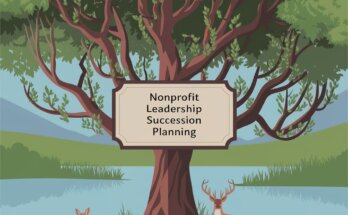In today’s fast-paced world, innovation is not just a buzzword; it’s a vital component of successful nonprofit leadership. The role of innovation in nonprofit leadership is crucial for organizations aiming to adapt, grow, and impact their communities effectively.
As the landscape of social challenges evolves, nonprofits must embrace new ideas, technologies, and strategies to remain relevant and efficient.
In this blog post, we’ll explore the various ways innovation can enhance nonprofit leadership, providing practical examples and strategies that leaders can implement.
Understanding Innovation in Nonprofit Leadership
To start, let’s break down what innovation means in the context of nonprofits. Simply put, innovation refers to the introduction of new ideas or methods that can improve processes, services, or products.
For nonprofit organizations, this could mean leveraging technology to enhance service delivery, developing new fundraising strategies, or creating programs that address emerging community needs.
A study conducted by the Nonprofit Innovation Alliance found that organizations that prioritize innovation are more likely to achieve their missions and engage stakeholders effectively.
This clearly indicates that innovation is not merely a luxury, but a necessity in today’s nonprofit sector.
Why Innovation Matters in Nonprofit Leadership
- Adaptability: Nonprofits operate in dynamic environments where community needs change rapidly. By fostering a culture of innovation, organizations can quickly adapt to these changes, ensuring they meet the needs of the communities they serve.
- Efficiency: Innovative practices can streamline operations, reduce costs, and maximize resource utilization. This means that nonprofits can do more with less, ultimately leading to greater impact.
- Attracting Talent and Funding: Nonprofits that are seen as innovative often attract talented individuals who want to be part of forward-thinking organizations. Additionally, funders are increasingly looking for organizations that demonstrate creativity and effective problem-solving skills.
Practical Strategies for Innovation in Nonprofit Leadership
Now that we understand the importance of innovation, let’s dive into some practical strategies that nonprofit leaders can implement to foster a culture of innovation within their organizations.
1. Encourage Creative Thinking
Creativity is the lifeblood of innovation. Nonprofit leaders should create an environment where team members feel safe to share their ideas without fear of criticism. This can be achieved by:
- Hosting brainstorming sessions: Regularly scheduled meetings focused on generating new ideas can help staff think outside the box.
- Implementing suggestion boxes: An anonymous method for team members to submit ideas can encourage participation from those who might be hesitant to speak up in meetings.
Example: At XYZ Nonprofit, the leadership team started a monthly “Innovation Day” where staff could present their ideas for new programs or improvements. This initiative led to the development of a successful community outreach program that increased engagement by 40%.
2. Leverage Technology
In today’s digital age, technology plays a significant role in driving innovation. Nonprofits should look for ways to incorporate technology into their operations, such as:
- Utilizing social media: Platforms like Facebook, Twitter, and Instagram can help nonprofits reach a broader audience, engage supporters, and promote their missions.
- Implementing project management tools: Software like Trello or Asana can streamline project management, making it easier for teams to collaborate and track progress.
Example: ABC Charity adopted a cloud-based project management system that allowed its dispersed team to collaborate in real-time. This not only improved communication but also resulted in a 25% reduction in project completion time.
3. Foster Partnerships
Collaboration with other organizations can lead to innovative solutions that benefit both parties. Nonprofits should seek partnerships with:
- Local businesses: These partnerships can provide access to resources, expertise, and funding opportunities.
- Other nonprofits: By collaborating with similar organizations, nonprofits can share best practices and pool resources to tackle common challenges.
Example: A local nonprofit partnered with a tech company to develop an app that helps connect volunteers with community service opportunities. This innovative collaboration not only increased volunteer participation but also enhanced the company’s community involvement profile.
A Story of Innovation in Action
Let me share a compelling story of innovation that highlights the transformative power of creative thinking in nonprofit leadership.
Imagine a small nonprofit dedicated to helping at-risk youth in a bustling urban area. For years, they relied on traditional methods to engage and support these young individuals, but the outcomes were stagnant. The leadership team realized they needed to innovate to make a real impact.
One day, during a brainstorming session, a young staff member proposed using virtual reality (VR) to create immersive experiences that would allow youth to explore different career paths and life skills. Initially met with skepticism, the idea gained traction as team members began to envision the potential benefits.
With a small grant secured from a local foundation, the nonprofit invested in VR technology and developed programs that enabled young people to virtually experience careers in medicine, technology, and the arts.
The impact was profound; youth were not only more engaged but also began pursuing education and career opportunities they had never considered before.
This story illustrates how embracing innovation can lead to meaningful change, inspiring others in the sector to think creatively about their own challenges and opportunities.
4. Measure Impact and Iterate
To innovate effectively, nonprofits must assess the impact of their new initiatives continuously. This means:
- Collecting data: Use surveys, feedback forms, and analytics to understand how programs are performing and how they can be improved.
- Being open to change: Innovation is an iterative process. If something isn’t working, be willing to pivot and try a different approach.
Example: DEF Organization implemented a new mentorship program but found that attendance was low. After surveying participants, they learned that the scheduling was inconvenient. By adjusting the meeting times and providing virtual options, attendance improved significantly, demonstrating the importance of adaptability in innovation.
5. Cultivate a Learning Culture
Nonprofits should prioritize ongoing learning and professional development for their staff. This can be done through:
- Workshops and training: Offer opportunities for staff to learn about new trends, technologies, and methodologies.
- Encouraging external learning: Provide resources for staff to attend conferences, webinars, or online courses related to their field.
Example: GHI Foundation established a professional development fund that allowed employees to attend workshops and conferences. This investment not only boosted staff morale, but also resulted in the introduction of several innovative practices within the organization.
6. Communicate the Vision
Finally, it’s crucial for nonprofit leaders to communicate their vision for innovation clearly. This involves:
- Setting clear goals: Define what innovation means for your organization and set specific, measurable objectives.
- Sharing success stories: Highlighting examples of successful innovations within the organization can inspire others to get on board and contribute.
Example: JKL Nonprofit held regular town hall meetings where leadership shared updates on innovative projects and their impacts. This transparency fostered a sense of community and encouraged more staff members to share their ideas.
Embrace Innovation for Impact
The role of innovation in nonprofit leadership cannot be overstated. By fostering a culture of creativity, leveraging technology, building partnerships, measuring impact, cultivating a learning environment, and clearly communicating a vision, nonprofit leaders can position their organizations for success in an ever-evolving landscape.
By implementing these strategies, nonprofit leaders can not only drive innovation, but also inspire their teams to contribute to a collective vision of positive change. Remember, the future of your organization—and the communities you serve—depends on your willingness to innovate and adapt.
Are you ready to take the next step in enhancing your nonprofit’s impact through innovation? Subscribe to the Nonprofit Navigators Newsletter today for more expert tips and resources!
Join our community to access exclusive opportunities, including job openings, grant opportunities, webinars, and events that can help you and your organization thrive. Let’s innovate together for a brighter future!
Additional Resources:
- The Small Business’s Guide to Winning Grants
- Request for Proposal Success: How to Write Proposals That Win
- The Ultimate Guide to Federal Grant Applications: Techniques for Success
- Digital Marketing for Nonprofits: A Comprehensive Guide to Boosting Your Impact Online
- Mastering Online Fundraising: A Nonprofit’s Guide to Digital Success




